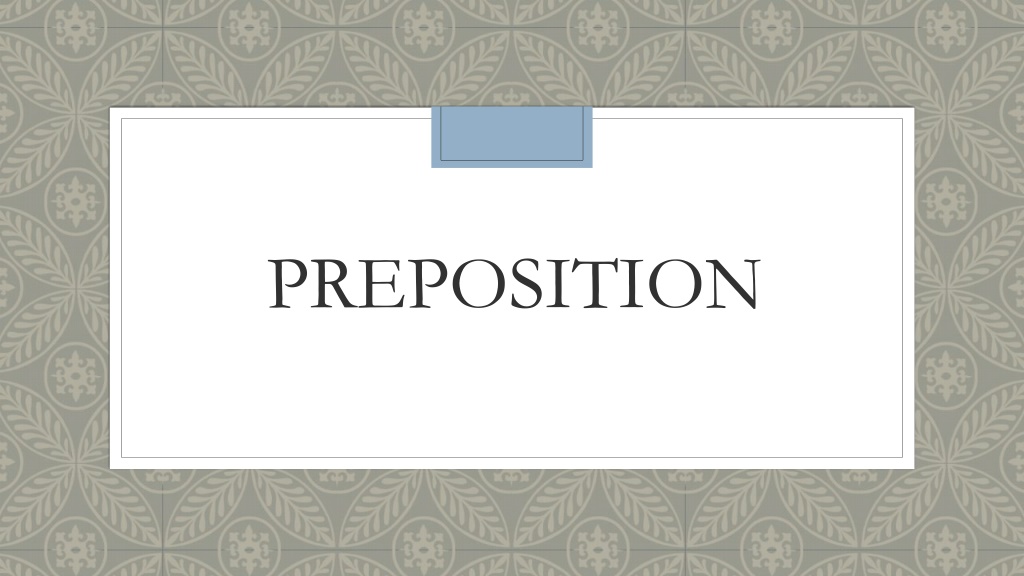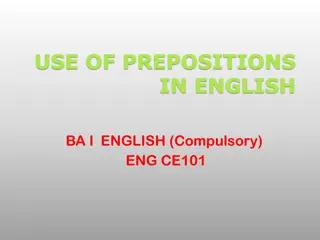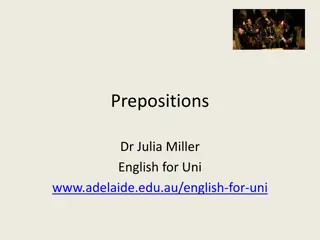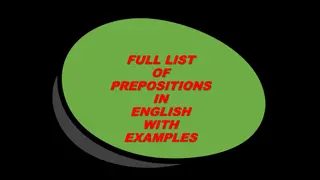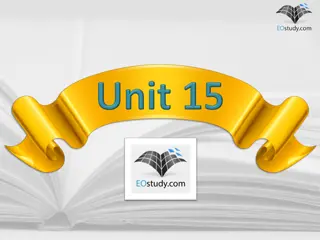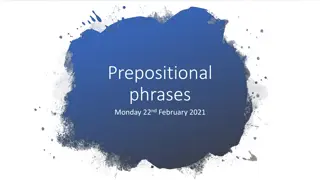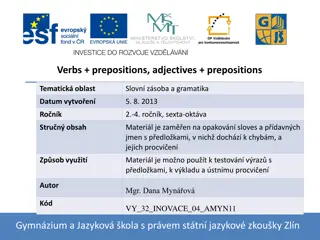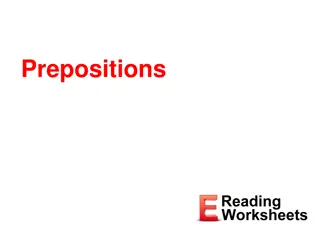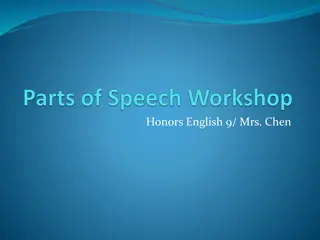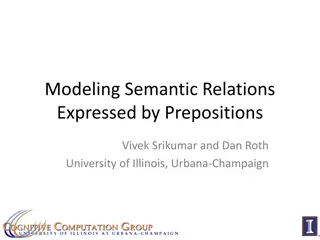Prepositions: Types, Functions, and Examples
Prepositions play a crucial role in linking nouns, pronouns, and phrases to other words in a sentence, describing various relationships. They can be classified into simple, compound, phrase, and participle prepositions, each serving different purposes such as indicating place, time, agency, manner, and more. Explore the different kinds of prepositions and their functions through examples and visual aids.
Download Presentation

Please find below an Image/Link to download the presentation.
The content on the website is provided AS IS for your information and personal use only. It may not be sold, licensed, or shared on other websites without obtaining consent from the author.If you encounter any issues during the download, it is possible that the publisher has removed the file from their server.
You are allowed to download the files provided on this website for personal or commercial use, subject to the condition that they are used lawfully. All files are the property of their respective owners.
The content on the website is provided AS IS for your information and personal use only. It may not be sold, licensed, or shared on other websites without obtaining consent from the author.
E N D
Presentation Transcript
DEFINITION A preposition links nouns, pronouns, and phrases to other words in a sentence. It describes a relationship between other words in a sentence. 1. It is a letter for you. 2. This book is on the table. 3. They met before lunch.
KINDS OF PREPOSITIONS Simple Preposition Compound Preposition Phrase Preposition Participle Preposition
SIMPLE PREPOSITION Prepositions at its basic form Eg: At/ By/ For/ From/ In/ Of/ Off/ On/ To/ With/ Up
COMPOUND PREPOSITION Generally formed by prefixing a Preposition to a Noun, an Adjective or an Adverb Eg:About/Above/Behind/Below/Within/Without/Inside/Outside/ Between/Beneath/Amongst
PHRASE PREPOSITION Groups of words used with the force of a single preposition Eg: According to/ By means of/ In order to/With regard to/ For the sake of/ Because of/Away from
PARTICIPLE PREPOSITION Present participles of verbs used absolutely without any noun or pronoun being attached to them Eg: Concerning/Considering/Touching/Respecting/Regarding/ Pending
RELATIONS EXPRESSED Place Time Agency, Instrumentality Manner Cause, Reason, Purpose Possession Measure, Standard, Rate, Value Contrast, Concession Inference, Motive, Source, Origin
PLACE 1. Went about the world 2. In the sky 3. Lay under the table 4. Fell among thieves 5. Stood before the door 6. Within the house
TIME 1. After his death 2. Wait till tomorrow 3. For many years 4. By three o clock 5. Towards evening
AGENCY, INSTRUMENTALITY 1. Sell goods at auction 2. Destroyed by fire 3. Cut it with a knife 4. Sent the parcel by post
MANNER 1. Dying by inches 2. Fought with courage 3. Won with ease
CAUSE, REASON, PURPOSE 1. Died from fatigue 2. Shivers with fever 3. Laboured for good of humanity 4. Did it for our good
POSSESSION 1. The mosque of Omar 2. A man of means 3. The boy with red hair
MEASURE, STANDARD, RATE, VALUE 1. I am taller than you by two inches. 2. He charges interest at 9%. 3. Cloth is sold by the yard.
CONTRAST, CONCESSION 1. For one enemy he has a hundred friends. 2. With all his faults, I admire him. 3. After every effort, one may fail.
INFERENCE, MOTIVE, SOURCE, ORIGIN 1. From what I know of him, I hesitate to trust him. 2. His skill comes from practise. 3. Light emanates from the sun.
OPPOSITE 1. Ram is sitting opposite Shyam. 2. His house is opposite to ours.
IN FRONT OF 1. He parked the car in front of the hotel. 2. He put the plates on the table in front of us.
OVER Used to talk about a movement from one side of a place to another, such as surfaces or lines 1. I shall jump over the wall and open the gate. 2. The aircraft flew over the lake.
ACROSS Used to express position in relation to something which stretches from one side of a place to another. 1. There was a barrier across the road. 2. The bank is across the street.
ALONG Used to show the movement following a line 1. He walked along the line. 2. They were walking along the road. 3. Well-wishers began placing flowers along the railings. 4. Somewhere along the path, there is a sign post.
TO Indicates movement with the aim of a specific destination which can be a place or an event 1. I am going to USA tomorrow. 2. Are you going to the party? 3. What time did you go to work? 4. Can you tell me the way to the station?
UP TO Often used to express movement to a person. 1. She came up to me and asked me what the time was.
TOWARDS Indicates movement in a particular direction. 1. She was carrying a suitcase and walking towards the railway station. 2. He hit the ball towards the goal.
AT Used for a precise time 1. At 3 o clock 2. At 9 am 3. At sunrise 4. At night 5. At the moment 6. At present 7. At the same time
AT Used for a point 1. At the corner 2. At the bus stop 3. At the entrance 4. At the top of the page 5. At the crossroads 6. At the end of the road
AT vs IN AT is used for a small place IN is used for a big place 1. He lives at Alwar in Rajasthan. 2. A temple is situated at Madurai in Tamil Nadu.
AT vs IN AT shows stable position IN shows movement 1. She is at home. 2. The taxi is in motion.
IN Used for enclosed space 1. In the garden 2. In Delhi 3. In India 4. In a car 5. In my wallet 6. In a box
IN Used for long periods, centuries, years and months 1. In 1990 2. In the next century 3. In the Ice Age 4. In the past 5. In the morning 6. In the mornings
IN Used for existing state of things 1. He is swimming in the river. 2. There are 25 students in the class.
ON Used for days and dates 1. On Sunday 2. On Tuesdays 3. On 6thMarch 4. On Independence Day 5. On my birthday 6. On Monday evening
ON Used for a surface 1. On the ceiling 2. On the page 3. On the carpet 4. On the door 5. On the floor
